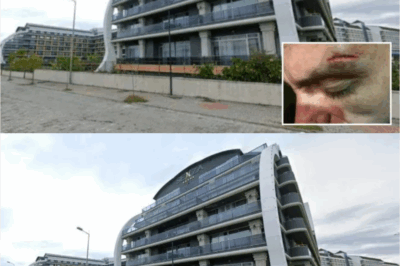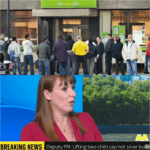In a dazzling and unexpected announcement that stunned both the aviation and tech industries, Elon Musk unveiled Tesla’s latest innovation: a $13 billion electric aircraft that he claims incorporates a never-before-seen feature that “defies the laws of physics.” The announcement took place at a Tesla event streamed globally from a private airfield in California, where the sleek, futuristic aircraft was revealed beneath dramatic lights and heavy anticipation.

The Tesla Plane, dubbed “Model Aether,” marks the company’s first major leap into the aviation sector. Musk, known for blurring the boundaries between science fiction and reality, declared during the presentation that the aircraft represents “the most disruptive advance in aerospace since the invention of flight.” He described it as a zero-emission, fully autonomous aircraft capable of vertical takeoff and landing (VTOL), with the capacity to revolutionize not just travel, but how humans conceptualize movement itself.
The design of the aircraft is unlike anything currently seen in commercial or private aviation. Shaped like a hybrid between a jet and a spacecraft, the Model Aether features a seamless carbon-fiber body, silent electromagnetic propulsion systems, and a transparent canopy with a panoramic 360-degree view. It is capable of flying at Mach 1.8, according to Musk, and uses ultra-lightweight solid-state batteries to achieve flight ranges far beyond any existing electric aircraft.
But the most sensational claim made during the unveiling was Musk’s statement that the Tesla Plane possesses a unique flight stabilization and propulsion system “that seems to challenge our current understanding of physics.” While Musk did not go into full technical detail—citing pending patents and national security consultations—he hinted at a breakthrough involving “quantum gyroscopic inertia control” that allows the plane to maneuver with unprecedented agility and efficiency, even in zero-lift conditions.
Skepticism erupted almost immediately from the scientific community, with several prominent physicists and aerospace engineers urging caution. Dr. Lisa Montrose, a senior researcher at the International Aeronautics Institute, said, “If what Musk claims is accurate, this would rewrite key elements of modern physics. But extraordinary claims require extraordinary evidence.” However, some experts left open the possibility that Musk has leveraged emerging quantum or material science innovations that are not yet widely understood or published.
Musk, never one to shy away from controversy or ambition, addressed the skepticism head-on during the event. “I know how this sounds,” he admitted with a grin. “But if we stopped every time someone said something was impossible, we’d still be riding horses.” He invited researchers and aviation authorities to participate in upcoming demonstration flights and promised full transparency once initial testing phases are completed.
From a commercial standpoint, the Tesla Plane is aimed at both high-speed urban mobility and long-range intercontinental travel. Musk envisions a future in which aircraft like the Model Aether replace not just private jets, but also commercial airliners and even some forms of high-speed rail. He claims the aircraft’s efficiency and zero-emission design will eventually make it both cost-effective and environmentally friendly, addressing one of the aviation industry’s most persistent criticisms: carbon pollution.

The price tag of $13 billion refers to the aircraft’s development cost, not its per-unit price, although Musk hinted that individual planes could retail for as low as $50 million within the next five years. That would place it within reach for governments, major corporations, and even commercial air carriers looking to upgrade their fleets with next-generation technology. Musk also stated that Tesla has already received “serious inquiries” from multiple countries interested in deploying the aircraft for both civilian and emergency use.
In a surprise twist, Musk revealed that the development of the Tesla Plane was partly conducted in secret under the codename “Project Icarus,” and that early prototypes have been flying in undisclosed test zones for nearly a year. Video footage shown during the presentation depicted a craft rising vertically into the sky, performing an aerial spin maneuver, and accelerating away at supersonic speed—all with near-silent operation.
As part of its forward-looking strategy, Tesla plans to integrate the Model Aether with the broader Tesla ecosystem. The aircraft will be operable through a Tesla app, fully automated with AI navigation, and capable of interfacing with Starlink satellites for seamless global communication and guidance. Musk also hinted at a future “Tesla Skyport” network that would allow Aether aircraft to land on specially designed vertical pads in cities, remote regions, and offshore platforms.
This grand vision, while exciting, has also raised serious regulatory and logistical questions. Airspace authorities, including the FAA and ICAO, are expected to scrutinize the aircraft’s performance claims and safety standards before allowing any form of public use. There will be questions about where such craft can legally fly, how air traffic control would adapt to widespread autonomous aerial vehicles, and what protocols are in place in the event of system failures or electromagnetic interference.
Despite these challenges, early reactions from the tech world and Tesla investors have been overwhelmingly positive. Within hours of the event, Tesla’s stock saw a sharp uptick, and online forums erupted with both awe and incredulity. The idea of an aircraft that breaks known rules of motion is both thrilling and controversial, and it has stirred comparisons to revolutionary moments in history such as the Wright brothers’ first flight or the launch of the Concorde.
Musk, for his part, appears unshaken by the magnitude of his claims. “We’ve done it before, and we’ll do it again,” he said as the presentation closed. “People laughed when we said electric cars could outrun supercars. They said rockets couldn’t land themselves. Now, they say a plane can’t break the rules of physics. We’ll see.”
The world will now wait to see if Tesla’s most ambitious project yet can truly deliver on its promises—or if it will join the ranks of bold ideas that stumbled beneath their own ambition. If successful, the Model Aether could usher in a new epoch of travel that collapses geography, reshapes commerce, and redefines the limits of human engineering. If not, it will serve as another reminder of how fine the line is between genius and hubris.
Either way, one thing is certain: the future of flight just got a lot more interesting.
News
“BANKRUPT BRITAIN?!” – Labour’s Plan to WATER DOWN Its Already Flimsy Welfare Reforms Could HURL the UK Into TOTAL FINANCIAL MELTDOWN
LABOUR is making a complete mess of welfare. Panicked and driven Left-wards by Reform’s surge, the Government is wobbling on the…
“TURKISH HOTEL TERROR!” – Brit Dad Brutally BEATEN TWICE in Front of His Kids… Family Holiday Spirals into a Living Nightmare
The alleged attackers reportedly had a feared reputation A DAD-OF-TWO said he was attacked twice in front of his kids…
“FED to PIRANHAS!” – 31-Year-Old Mum of 3 Vanishes After Ex’s Savage Revenge… Body Still Missing in Brazil
A MAN was caught on CCTV putting his former wife’s body in the boot of a car before coldly dumping…
“Dinner Party of DEATH!” – You Won’t Believe Erin Patterson’s Gross Confession After Her ‘Killer’ Mushroom Meal Claimed 3 Lives
MUSHROOM cook Erin Patterson who is accused of killing three people with a poisoned beef wellington graphically described how she…
HOLIDAY BLOODBATH! Teen SLASHED to Death with Broken Bottle in Lisbon—UK Tourist (27) DRAGGED Back to Portugal in Dramatic Midnight Extradition
Daniel was reportedly attacked while trying to defend a friend A BRITISH tourist has been arrested and extradited to Portugal…
LIVERPOOL PARADE CARNAGE! 53-Year-Old Driver PLOUGHS into Crowd—47 Injured, 4 Kids Hurt—Police Shout “NOT TERROR!” Fans in SHOCK
Emergency crews arrived to find people lying injured in the road and some trapped under the car FOUR children were…
End of content
No more pages to load












